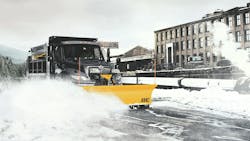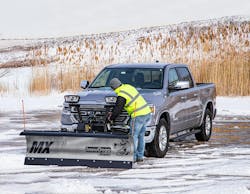Upfitting snow plows for the winter season
As the trucking industry heads into autumn, many fleets are taking the time to winterize their trucks and trailers. Meanwhile, municipal fleets and snowplow companies may be pulling out their plows to evaluate if they need repairs or replacement.
If you are new to this process, or just getting started, here are a few considerations to keep in mind from upfitting experts at Douglas Dynamics and Buyers Products and how to take care of your plows so they work through the winter.
Repair or replace?
For many fleets, the first question is about the size and types of properties they will be plowing. And according to Erin Hunt, senior product manager at Douglas Dynamics, and snowplow manufacturer and upfitter, this coincides with the truck and the type of plow needed.
“Typically, the life expectancy of a plow is about five to seven years,” Hunt explained. “It usually coincides with how long they keep the vehicle that the plow is attached to. In general, when folks get a new vehicle, they often will get a new plow.”
But for a more specific method of gauging a fleet’s snowplow needs, Scott Moorman, director of snow and ice at Buyers Products, a manufacturer of work truck equipment and trailer accessories, pointed to cost as an indicator of when to replace equipment. Like most work trucks, when to repair or replace a plow is based on how much it’s costing you to upkeep.
"It's a lot like a car,” Moorman stated. “If you’ve got major mechanical issues on an older plow and need to spend $2,000 to fix it, it’s time to start looking at a new plow. Reliability is the most important feature of any plow, so you want that peace of mind in the middle of a storm.”
Hunt also noted that getting new upfits can be a strategic decision for fleets in terms of making service and maintenance easier.
“What's really important to fleet managers is that they have consistency,” she noted. “So you will see most people are buying the same vehicle and the same plow for all 100 vehicles in their fleet, for example.”
Basic types of plows
There are three main categories of plows to choose from: Straight blade, V plows, and wing plows.
Straight blades are your basic workhorse, which don’t have a lot of moving parts and are pretty simple.
“[These are] good for someone who's starting out, or if you're someone who has a large fleet, you're probably going to have a range of people who have had experience snowplowing, so these are always a great entry point,” Hunt said.
Meanwhile, V plows will tend to be more versatile, and can provide more positions for varying snow conditions or breaking through ice, kind of like a “two-for-one” Hunt said. However, this comes with more moving parts and complexity, which can increase training time for new operators.
Finally, there are wing plows, which Hunt said feature straight blades with expanders that come out of the wings for a larger plowing surface area.
These are “good for parking lots, for an example, since you can cover a lot of surface area in a short amount of time or with fewer passes,” Hunt noted.
Considering truck and plow weight
But looking at plow types and knowing what kind of surface you’ll be clearing isn’t the only consideration you need to make for snowplow upfits. Understanding the truck you have at your disposal and your weight limitations is a critical first step to choosing your upfit. Ideally, Moorman said that a fleet would first know what plow they need for their application and then select the truck for the plow.
“If you're picking a truck, a four-wheel drive is infinitely preferable,” Moorman explained. “Diesels are great, reliable trucks, but they actually limit your choices with plows considerably, because they take so much of the front-end capacity.” This is a fact that often surprises customers after they've already bought a truck and are trying to match up with a plow, he said.
But more often than not, fleets are working based on the light trucks they already own, which means they have to be careful to choose a plow that’s right for the truck, which means keeping in mind a truck’s weight capacity. Moorman described the plow and truck matchup as something like a teeter-totter, with the truck as the fulcrum between added ballast in the rear and the plow at the front.
When choosing your plow, the goal is to keep the truck’s center of gravity roughly between the front and rear axles to maintain proper steering and braking. And while you can choose a heavier plow and attempt to balance out the weight with ballast in the back, there comes a point where that becomes unrealistic, since you don’t want to exceed the rating on the rear axle.
“It's not a matter of, ‘Okay, my front axle weight rating is 5,600 pounds, and my plow weighs 1,200 pounds, so I’ve got plenty of room,” Moorman stated. "That's not really how it works, because the plow is hanging out in front of the truck, and that front axle weight rating is already taken up a lot by the engine, and the passengers, to some extent.”
You can sometimes offset the plow weight with ballast, you can't realistically add much more than 1,000 lbs. of ballast, Moorman said. While you can sometimes get the right balance with a salt spreader on the back of your truck, sometimes it might be better to get a smaller plow to start with.
This is why matching your plow to your truck is so important. Fortunately, many manufacturers provide matching software to see what plows are compatible with your truck.
“Fisher has a tool on our website called eMatch, and it's a snowplow selector tool where you put in the vehicle that you're planning to attach the plow to, and it will tell you all of the options for optimal performance and safety,” Hunt noted. “You put in your vehicle, make, model, and year, and the tool will help walk you through what's available and what you need to make that applicable to your truck.”
Then you have to make sure your electrical system will be able to handle the plow, and make sure that the plow’s mounting hardware and hydraulics will all work well, she continued. According to Moorman, the electrical installation can get particularly tricky as trucks get more and more compact under the hood.
“You've got the harness running under the hood, going through the grille,” Moorman said. “And then the trickiest part, depending on the truck, is the headlight adapters. We try to make the electrical install as easy as possible with plug-and-play wiring, but some trucks will always be more difficult than others to interface with the headlights. Ford and RAM have really made it easiest in terms of an upfitter connector.”
Then, fleets can make choices on accessories, including the choice between halogen or LED lights, what kind of controls they want, if they want blade guides (for visibility in the truck), and shoe kits for height consistency.
Maintenance and upkeep
Of course, after all the effort to upfit a plow, fleets will need to get as much as they can out of their investment with proper maintenance. According to Moorman, a large part of this is not treating the plow like a bulldozer, which can damage the plow.
“Don’t take out trees with it,” Moorman added. “Typically, if a weld fails, it's probably [due to] the operator, and I can only say that because we see it so rarely. If you're bending things, it's probably one of those extreme cases where you're just plowing through banks.”
But for basic maintenance, he advised that snowplow fleets pay attention to a plow’s hydraulics, and to take care of leaks quickly. Similarly, keep an eye on your hydraulic fluid and change it out if it gets contaminated with water.
“These aren't always things that you have to do every season, but change your fluid, maybe every other season, depending on how much use the plow is getting,” Moorman said. To help avoid that contamination, fleets should also check their hydraulic hoses for wear.
Then, of course, there’s the usual work of greasing a plow’s pivot points, tightening your mounting bolts, and checking its electrical harness for wear. This is especially critical because plows work around abrasive chemicals used for de-icing.
“There's so much salt used in so many parts of the country, so if you want your plow to stay in great shape, keep your plow clean after use, spray it with some grease to protect it in the off season, and check your cutting edge to make sure you're not wearing into the bottom angle of the plow,” Moorman advised.
The same goes for any chips in the powder coating. To avoid corrosion, touch up any damaged paint, and try to store your plow indoors, if you can. Finally, another part of the plow where you need to watch for corrosion is the truck’s battery.
“Corrosion will happen everywhere eventually, no matter what magic sprays you use, or how much you tighten things,” Moorman advised. “So as often as you can think about it, get under the hood, check your battery terminals, clean them if you need to, check that solenoid, make sure everything's still tight there, because plowing causes a lot more vibration than normal driving.”
After all, Moorman noted that loose electrical connections could cause a heat build-up at the battery connections, which could also invite more corrosion. This risks a plow ending up with a failure where the operator now needs to replace a harness or motor instead of just cleaning their battery connection.
About the Author

Alex Keenan
Alex Keenan is an Associate Editor for Fleet Maintenance magazine. She has written on a variety of topics for the past several years and recently joined the transportation industry, reviewing content covering technician challenges and breaking industry news. She holds a bachelor's degree in English from Colorado State University in Fort Collins, Colorado.

